Cohort-Based Learning: A Comprehensive Guide

You’ve probably encountered engagement issues in your training programs.
What’s one way to fix this? Cohort-based learning. Instead of passively clicking through dull modules, this approach brings people together, providing learning alongside peers to discuss, collaborate, and apply what they learn in real time.
In 2024, 69% of organizations found cohort-based learning to be one of the best learning approaches to boost employee engagement and development. How? That’s what we’ll address in this article by examining benefits, examples, and implementation tips.
But first, let’s clarify what cohort-based learning is.
What Is Cohort-Based Learning?
Cohort-based learning is a learning strategy wherein a group with shared learning goals moves through a course or program together.
It’s a lot like a regular classroom setting — except that the courses are taken online, on digital platforms. Adult learners follow the same schedule, work on the same assignments, and take part in group activities under the guidance of an instructor or mentor.
How does it differ from self-paced learning?
Cohort-style learning is all about interaction and teamwork — it includes real-time sessions, a clear schedule, and set deadlines. This setup creates an interactive learning environment and urges participants to complete the course as a team.
On the flip side, self-paced learning takes a more independent approach. Instead of live sessions, learners get access to pre-recorded materials and can study at their own pace.
Cohort-based Learning vs. Self-paced Learning: Key differences | ||
| Cohort-based Learning | Self-paced Learning | |
| Has a fixed schedule | Timeline | Has no deadline or schedule |
| Brings people together through shared goals and experiences | Learning community | Takes a solo approach with little to no peer interaction |
| Synchronous; includes live courses and releases materials step-by-step | Content type and access | Asynchronous; includes pre-recorded sessions that are available all at once |
| Supports two-way discussions between learners and instructors | Interaction | Involves one-way communication from the instructor and limited engagement |
| Learners push each other through guidance and feedback | Accountability | Requires learners to motivate themselves to stay on track |
Types of cohort-based learning models
You can conduct cohort learning in different ways. Here are the main types:
Facilitated cohorts
These courses are led by a dedicated instructor or expert who is the primary source of knowledge and support. They provide lessons, run live workshops, give feedback and reviews, answer questions, and conduct discussions to keep everyone engaged.
Peer-led training
Think of that friend who helps you understand a topic before an exam. In this type of cohort learning model, learners teach and support each other instead of depending on an expert.
For instance, if a software development team is learning a new framework, each member focuses on a different part of the technology and takes turns leading mini-workshops. One week, a frontend developer explains component architecture, and the next, a database specialist covers data integration.
Self-directed learning with cohort support
This hybrid learning cohort model blends self-paced learning with the support of a group. Learners study independently but stay connected through regular check-ins, group discussions, and shared deadlines.
Think about it like this: you’re in a professional writing group where members go through a set curriculum of videos and exercises at their own pace. But every two weeks, you meet with your group to share progress, tackle challenges, and give feedback on each other’s writing. This structure keeps everyone accountable, even without a formal instructor.
Cohort-Based Learning Examples
Here are some real-world examples of how companies are using this approach to train and upskill their teams.
Group coaching programs
Whether it’s students enrolled in traditional learning programs or employees in a company, group coaching brings people together to learn and grow. A coach leads the sessions, helping participants work toward personal or professional goals. The focus can vary — some groups build confidence, while others develop leadership or creative thinking skills.
For example, a company might bring in a coach to help mid-level managers improve their leadership skills. Through discussions, exercises, and real-life scenarios, the group learns from both the coach and each other.
Online training courses
Virtual collaborative learning helps remote learners connect through online education and build new skills together.
Ever since the pandemic, many companies have turned to this approach to train employees in groups, so everyone learns the same skills and processes at the same pace. These online cohort-based courses often mix independent learning — like watching videos and reading — with live or even in-person sessions when possible. This balance helps build a sense of community and keeps everyone accountable, no matter where they are.
Boot camps and workshops
Short, intense, and hands-on, these cohort learning programs are perfect for those who want to pick up new skills fast in a group setting.
Take a web development boot camp, for example. Over 12 weeks, 30 career-changers dive into full-time lessons, coding exercises, and team projects. Expert guidance and hands-on practice help people learn quickly while building strong connections through shared challenges.
Corporate Benefits of Cohort-Based Learning
As mentioned, many organizations see improved engagement with cohort-based learning. But what exactly makes it so effective? Let’s examine the benefits of cohort-based learning.
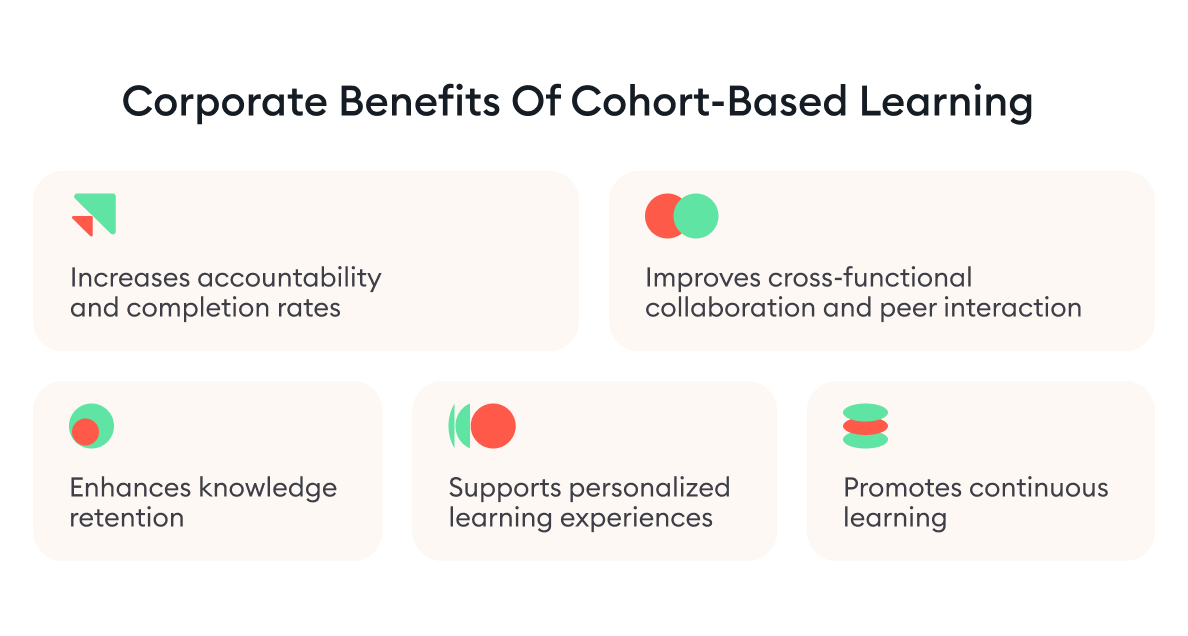
Increases accountability and completion rates
A course is only effective if people finish it, which is why completion rate is one of the most popular ways to measure its success.
Self-paced courses have a shockingly low completion rate — sometimes as low as 2% — because learners often lose motivation and drop out halfway through. But cohort-based programs, like those run by altMBA, boast a 96% completion rate!
That’s because learning in a group keeps you engaged, motivated, and supported every step of the way. When you’re surrounded by people working toward the same goal, it’s not just easier to stay on track, it’s more exciting to push yourself and do well.
Improves cross-functional collaboration and peer interaction
When people from marketing, finance, engineering, and customer service collaborate in real time, they get a deeper understanding of how their roles connect. This leads to enhanced peer interaction and optimizes team efficiency.
These learning groups eventually turn into online communities that provide employees with an open space to share new perspectives and ideas. This sense of community helps them learn through group discussions, solve issues, and stay committed to the learning process.
Enhances knowledge retention
Cohort-based learning isn’t just about going through material together — it helps you remember more.
Research shows that when you study alone, you might retain about 28% of what you learned after two days. Reviewing the material boosts that to 46%. But when you actively use what you’ve learned — answering questions, discussing with others, and applying concepts — you retain a solid 69%!
Why? Because real learning happens when you engage with the material. Discussing topics, explaining ideas to peers, and thinking through answers help build strong memory pathways that make the information stick.
Supports personalized learning experiences
Learning something new is already challenging, and it gets even more difficult when you’re expected to fit into a one-size-fits-all approach.
Traditional educational programs, like graduate degree curricula, cannot provide customized lessons for every student — but online cohort-based courses can, and they should if they want students to succeed.
Cohort programs recognize that every learner is different. With smaller class sizes and direct access to a coach, students get the one-on-one support they need. This allows for personalized learning paths based on individual goals, interests, and skill levels.
As a result, students can focus on areas where they need the most help, leading to higher success rates and a more meaningful learning experience.
Promotes continuous learning
Employees who train with their cohort members are more likely to form the habit of showing up and actively participating.
This teamwork often opens one’s mind to new ideas. A colleague might ask a question that no one else thought of or share an insight that shifts perspectives. Real-time collaboration like this keeps employees curious, motivated, and open to learning more.
And the more they learn, the more confident they become. Soon, they start seeing themselves as capable professionals who can take on challenges, develop skills, and contribute more to the company’s success.
Does Your Company Need Cohort Learning?
Cohort learning has numerous benefits, but whether it’s a good investment will depend on if your programs fall into one of these situations:
- If your employees need more than just information, e.g., they need hands-on practice and real discussions, a cohort model can make all the difference. It’s a great way to train cross-functional teams, especially when they’re required to collaborate on the same projects and stay in sync.
- Collaboration is the heart of cohort learning. So, if your workplace feels isolated, learner engagement is low, or knowledge sharing is a struggle, cohort training can turn things around.
- If you have a high employee turnover, cohort-based learning might be one of the ways to solve the problem. It builds stronger connections and gives your employees more reasons to stay.
Additionally, cohort learning significantly enhances the following training programs. In other words, if you’re focusing on one of these programs, implementing this collaborative approach to learning might be worth it.
- Leadership development programs. Help leaders connect and grow together through interactive programs, driving cultural change and better business results.
- Onboarding and new hire training. Teaches new hires how to settle in by building connections through collaborative learning.
- Soft and technical skills training. Involves role-playing and real-time feedback sessions for soft skills development, as well as hands-on projects and peer reviews for teaching technical skills.
- Executive educational programs. Gives senior leaders strategic insights and networking through expert-led discussions.
- Change management and innovation training. Supports employees navigate company changes with interactive workshops and shared strategies.
How to Successfully Implement Cohort Learning in the Workplace
So, you’ve decided to go for it. Cohort-based learning seems like a great fit for improving your training results.
Here’s how to increase the likelihood of its successful implementation.
1. Choose the right technology to deliver your courses
Once you’ve decided to bring cohort-based learning to your team, the first step is making sure you have the right learning tools to run it smoothly. And the most important tool? A learning management system (LMS).
Your LMS or cohort-based learning platform is the central hub for your program. It’s where learners access course materials, submit work, and connect with each other. But what features should your LMS have to run cohort-based learning? Here’s what you should look for.
- Your LMS should make collaboration and real-time interaction easy. Look for features like shared workspaces and discussion forums where learners can exchange ideas, ask questions, and engage in group learning.
- Live sessions are key to building a strong learning community, so your LMS should integrate with tools like Zoom or Google Meet.
- Progress tracking is another must-have. Both instructors and learners should be able to see how everyone is doing. This facilitates accountability and makes it easier to spot who might need extra help.
- Interactive feedback is just as important. Instructors need a quick way to review assignments, and learners should be able to give each other feedback, too. Examples of interactive feedback features are comments, messages, and course reviews.
iSpring Learn LMS
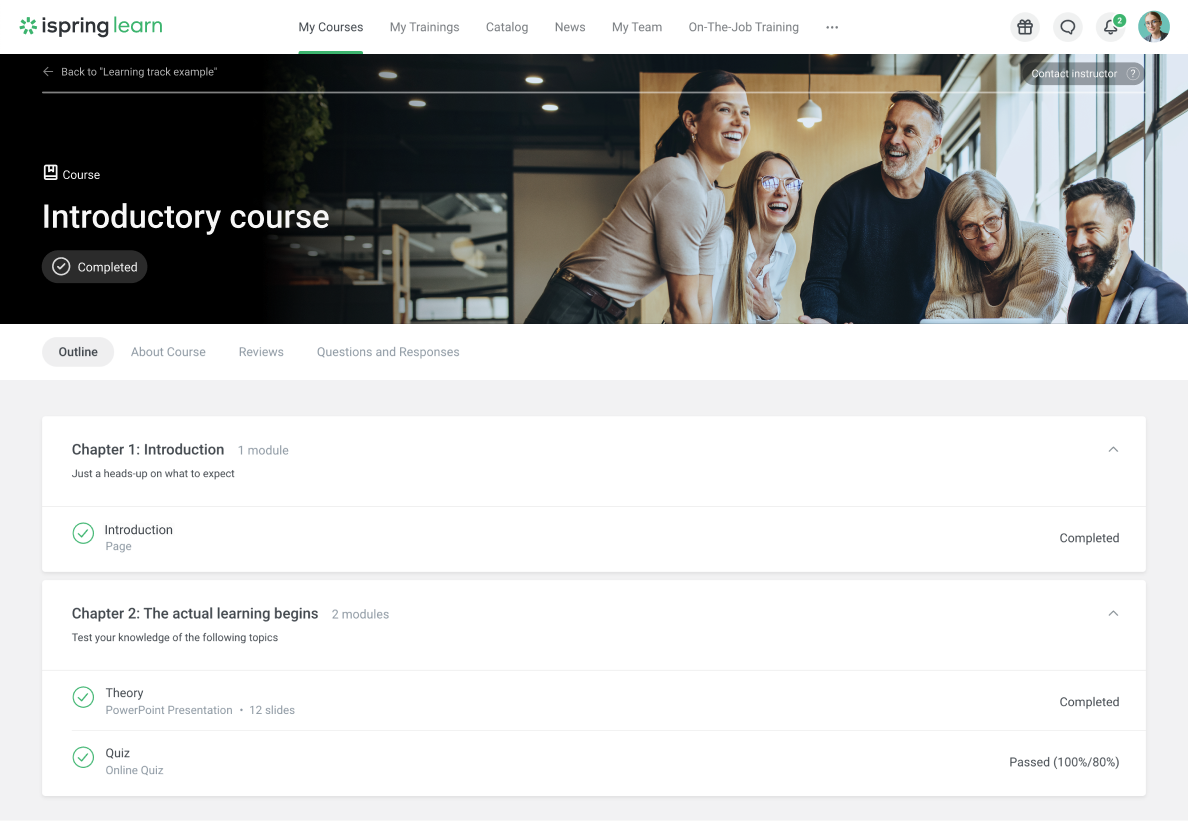
Course outline of introductory courses for onboarding processes on iSpring Learn
iSpring Learn is one of the most suitable LMSs for cohort-based learning. The platform enhances your group learning considerably.
iSpring Learn integrates easily with video conferencing tools like Zoom and Microsoft Teams to deliver live sessions. You even get access to detailed analytics and progress trackers to understand group engagement and individual progress.
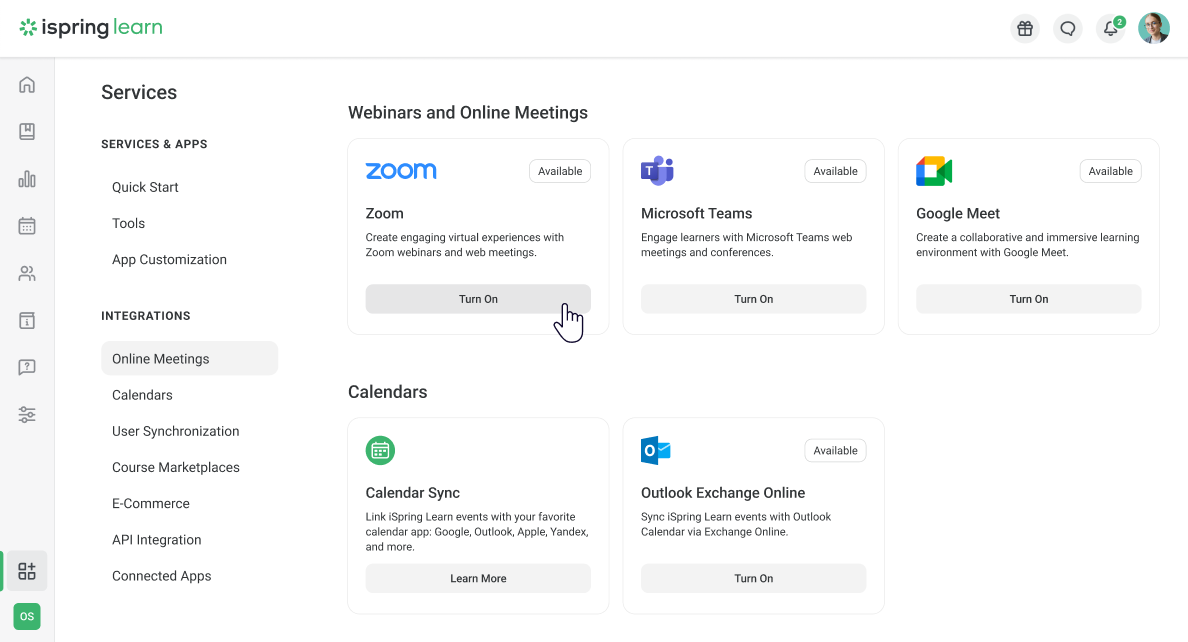
Connect with video meeting tools like Zoom and Teams to deliver real-time courses online.
iSpring Learn also helps you keep your employees’ attention through gamification. Elements like challenges, quizzes, and leaderboards turn learning into something fun instead of just another task.
A little friendly competition goes a long way — leaderboards and engagement scores can motivate employees to stay involved and push themselves to do better.
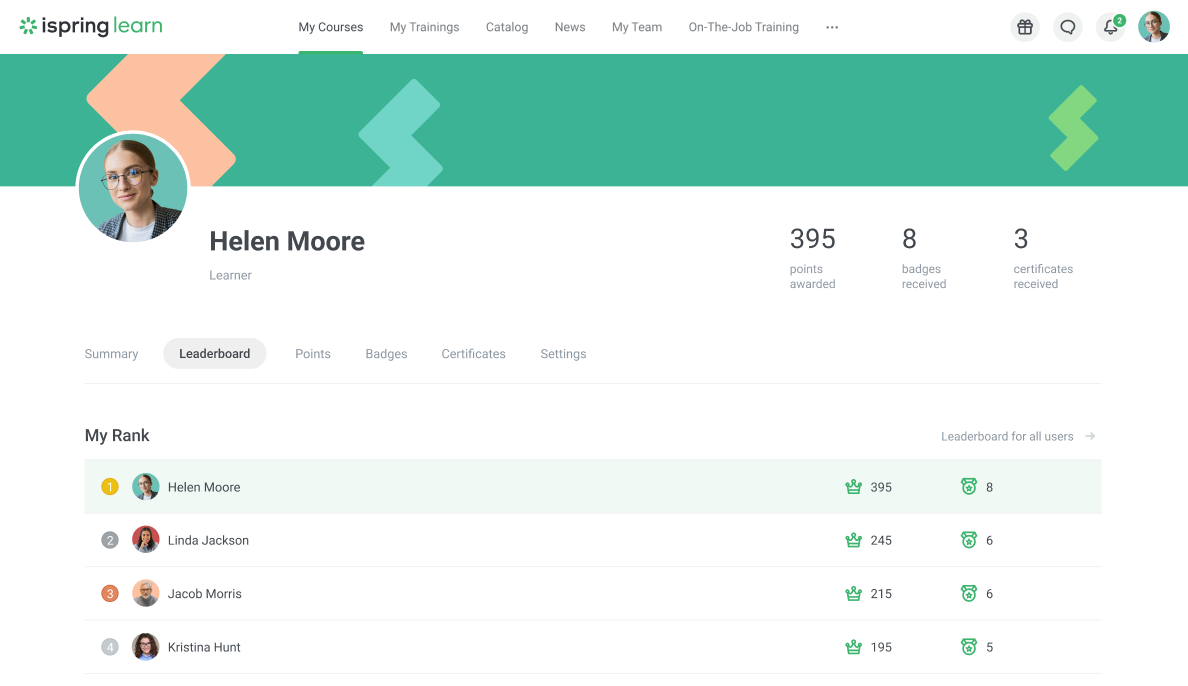
Gamify your cohort courses with scorecards and leaderboards on the iSpring Learn platform.
The platform also lets both instructors and peers post reviews of courses, which directly reflect their effectiveness. These reviews are usually public, allowing employees to consider the ratings before signing up for the course.
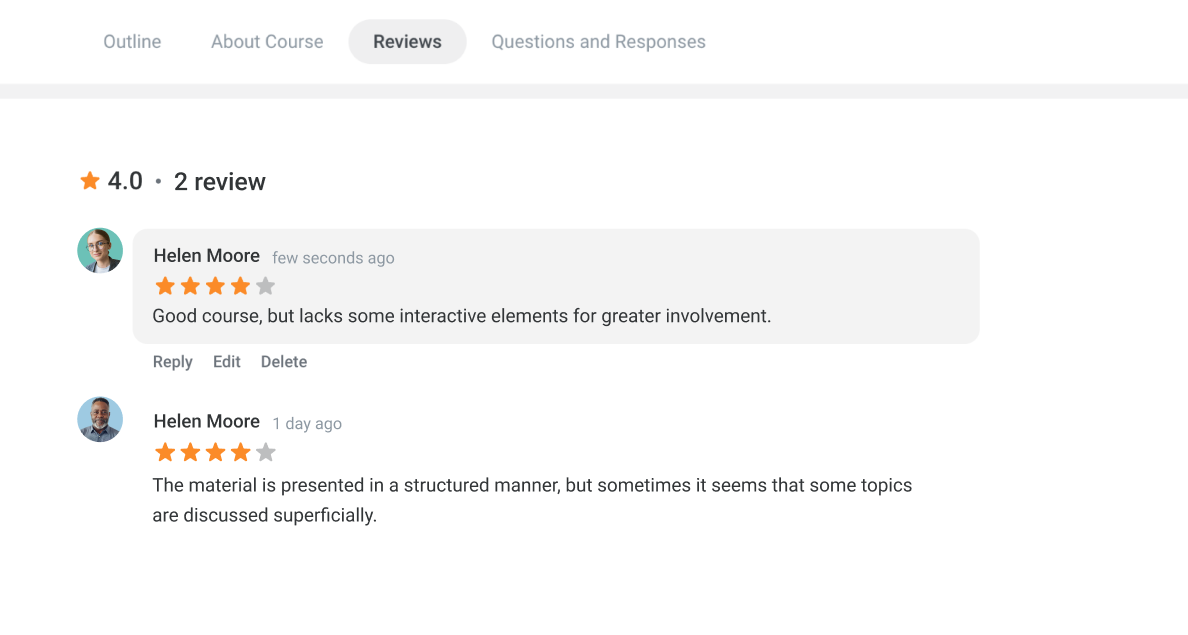
Rate the cohort-based courses you’ve completed and post reviews on the iSpring Learn platform.
Moreover, iSpring Learn provides you with an online space where you can stay connected with company updates, celebrate colleagues’ birthdays, welcome new members, and stay abreast of upcoming events.
Here’s an example of how iSpring Learn supports cohort-based online courses:
onCOGITE is a mental health support association that delivered 31 cognitive recovery courses (online!) to cancer survivors using iSpring Learn.
They ran weekly 90-minute virtual sessions during which 10-12 patients met with their instructor, received support, and practiced exercises to improve cognitive skills. Plus, all these exercises were built using iSpring’s authoring tool and were delivered through its cloud functionality.
You can try iSpring Learn during the 30-day free trial or first request a live demo.
2. Design a structured and collaborative curriculum
When your tech setup is ready, it’s time to design a curriculum that encourages collaboration.
Turn solo assignments into team projects where employees can brainstorm, present, or tackle challenges together. Incorporate interactive elements like case studies, simulations, and role-playing exercises to enhance engagement.
Set up live Q&A sessions, structured peer feedback, and breakout discussions where employees solve issues in small groups. You can also include fun, score-based games and debates to fuel friendly competition and spark curiosity.
Pro tip. Tailor curriculums for different mini groups to make learning more engaging and collaborative.
3. Create a blended approach with self-paced elements
Talking things through with teammates is great, but research shows that people learn better when they take a step back to process what they’ve learned. Group learning keeps things engaging, but real growth happens when employees step back, connect the dots on their own, and then bring fresh insights back to the team.
Moreover, not all remote employees can always attend live sessions.
This is why a blended learning approach is better than solely synchronous group learning in most cases. Along with real-time sessions, you keep or add self-paced materials like pre-recorded videos, real-world case studies, and guides to initiate discussions.
As well, iSpring Learn is especially great for blended learning, providing collaborative tools and a unified ecosystem with iSpring Suite, a powerful yet simple PowerPoint-based authoring tool that comes bundled with the LMS.
4. Measure the success of cohort learning
Before you conduct your training, think about how you’ll measure its success. And not just by tracking completion rates — real success comes from seeing the actual impact of collaboration.
Pay attention to how engaged your learners are — how many employees are actively participating? Are they discussing topics, sharing insights, and completing assignments? High levels of engagement usually indicate that the program is working successfully.
But training numbers alone don’t tell the entire story. You also want to see if learning translates into performance. For example, if a sales team using cohort learning starts closing more deals, that’s a good sign that it’s having a positive impact.
Another useful approach is direct feedback. Ask employees if they feel more confident or equipped to do their jobs after the training. If they say they’re applying what they’ve learned and are seeing results, that’s a strong indicator of success.
Finally, give it time. Measuring learning impact too soon might not show the whole picture. Let the program run for at least six months and then examine the data to find shortcomings and areas that might need improvement.
Trends in Cohort-Based Learning in 2025
Here are some emerging trends in cohort-based learning in 2025 that you might want to experiment with in your training program.
Crowdsourced learning сontent
Crowdsourced learning content involves contributions from learners, as well as enriching training modules with varied viewpoints and real-world experiences. During live sessions, participants can co-create course materials by brainstorming solutions, sharing industry-specific examples, and collaborating on case studies.
This approach is especially valuable in leadership development, compliance training, and onboarding programs, where collective knowledge strengthens learning outcomes.
Extended Reality (XR)
When virtual meetings and asynchronous collaboration are not sufficient, XR technologies offer a way to train teams in a safe, immersive environment. With XR, learners can experiment together and develop teamwork skills in new and dynamic environments.
By combining Virtual Reality (VR), Augmented Reality (AR), and Mixed Reality (MR), XR enables advanced collaborative learning. This is particularly valuable in fields like aviation, maritime operations, and manufacturing, where realistic simulations improve training effectiveness.
Micro-credentials and certifications
These focus on practical, job-ready skills and offer flexible, online learning. Learners can stack them to build deeper expertise over time.
For example, a company might offer a data analysis credential program that covers Excel, SQL, and visualization tools, providing a certification upon completion.
Cohort-based learning makes these programs even stronger by adding real-world projects, peer feedback, and group discussions to apply skills in real time.
Integration with AI
New technologies like artificial intelligence are changing the way corporate training works, and cohort-based learning is no exception.
eLearning expert Kevin Brake has found that AI doesn’t just look at assessments to figure out strengths and weaknesses. It tracks how employees interact with content — what they click on, how fast they move through lessons, and whether they engage with feedback.
Using this data, it creates custom lesson plans that fit different learning styles — an approach that is especially beneficial to smaller groups. This helps training managers meet each employee’s immediate needs.
Conclusion
Jeff Schulz, Vice President of Professional Services, shared with InStribe that “Companies embracing contextual and cohort-based learning models will realize faster application of skills and better leadership pipelines, bridging the gap between training and tangible business outcomes.”
Cohort-based learning is more than just a training method; it’s a transformational approach to building community within your organization.
If you’re wondering how to improve training engagement, knowledge retention, and even employee retention, then it’s time to take collaboration in your learning more seriously.
Platforms like iSpring Learn provide a seamless way to implement cohort-based learning programs. You can try iSpring Learn during the 30-day free trial or first request a live demo.







